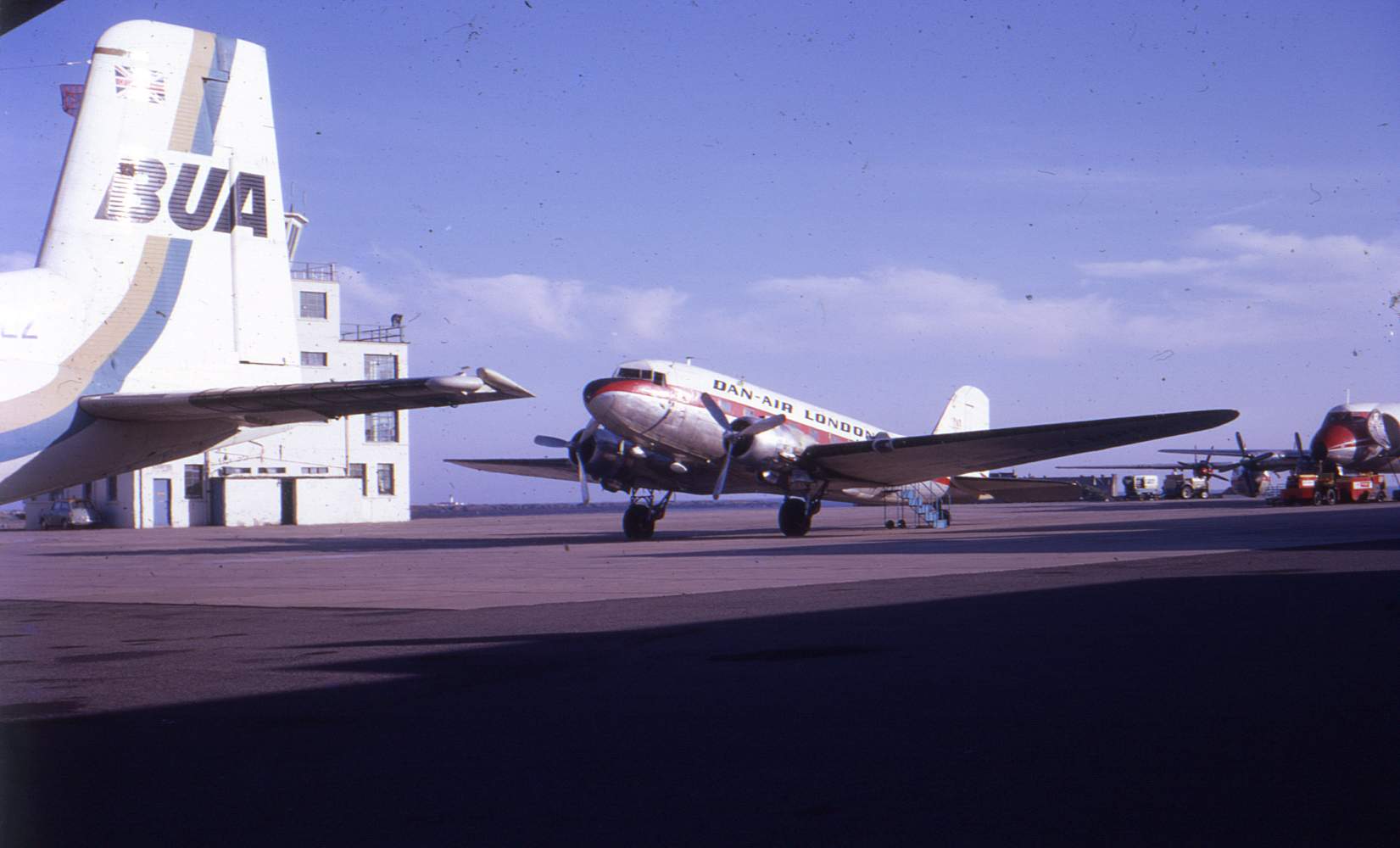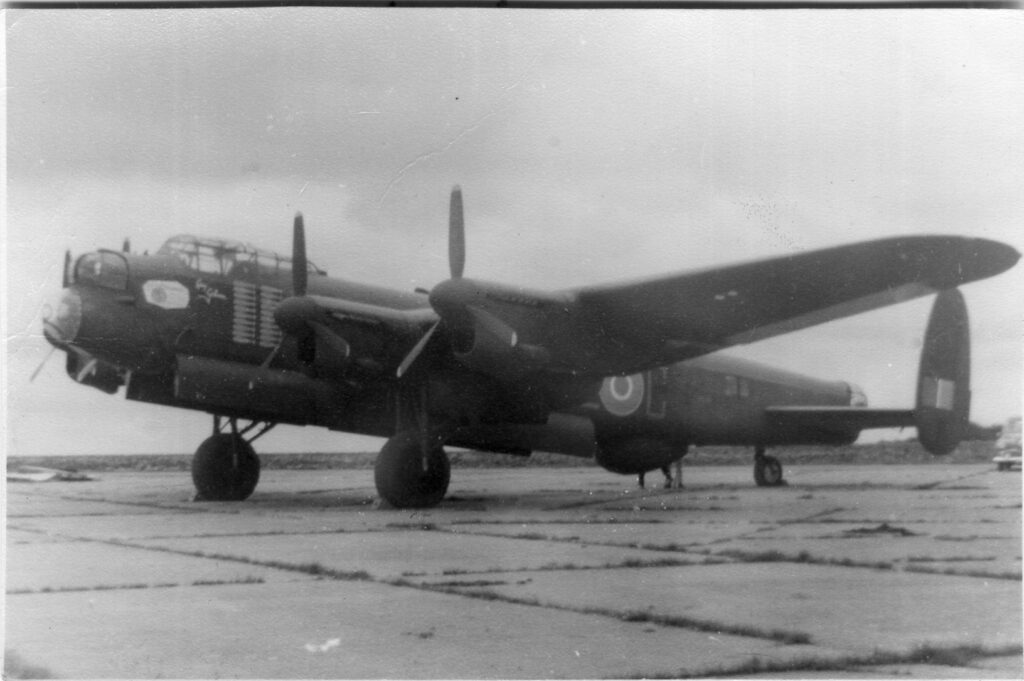
Lancasters have always achieved good coverage in the British press so, perhaps, it is no surprise that the Lincolnshire Aviation heritage Centre’s NX611 ‘Just Jane’ seems like an old friend. However, looking back over more than half a century, I can remember her inspirational effect on many occasions. The most memorable instance, for me, was back in 1969 when a weekend drive with my parents resulted in finding the Lancaster sitting prominently on a dispersal point at the abandoned ex-USAAF airfield at Lavenham, Suffolk. A sight never forgotten!
Prior to that, I had watched, with excitement, G-ASXX’s arrival at Biggin Hill in 1965 after an epic flight from Australia. The ex-bomber was still in her classic white Aeronavale colour scheme and was bedecked with the logos and insignia of many organisations which had sponsored her flight to the UK: Shell Aviation, ‘Spirit of Surfers Paradise’, names which conjured-up the excitement of world wide adventure.
Following her stay at Lavenham, it was some time before I saw her again. I had hoped to make the pilgrimage up the road to Blackpool to see her when the Reflectaire collection was auctioned, but never made it. Since then, I occasionally passed the old Avro when she was gate guardian at Scampton and I was driving up the Roman Road from Lincoln to the Humber Ports. However, I am looking forward to seeing her at her new home at East Kirkby, hopefully in 2024.
While no expert in Lancasters, I have put together a brief history from a variety of sources. A distinguished lady such as ‘Just Jane’ has had much written about her including a dedicated biography (1) and a recent history (2). There are also DVDs and several magazine articles featuring this historic bomber (3).
(1) Story of a Lanc, Brian Goulding, Mike Garbett and John Partridge, 1997. A later edition was updated by Brian Goulding and Richard Taylor.
(2) Just Jane: two farmers and a Lancaster by Jenny Walton.
(3) Avro Sisters produced by PlanesTV.com Ltd.
NX611 – Military life
Lancaster VII NX611 was built by Austin Aero Ltd at Cofton Hacket (Longbridge East) in April 1945 just as WW2 in Europe was drawing to a close. Originally destined to serve with the RAF’s ‘Tiger Force’ on missions to attack Japan from Eastern India and Okinawa, the capitulation of Japan left the air force with no immediate purpose for the Lancaster. Equipped with Merlin 24 engines and with an operational range of 3300 miles, NX611 carried the designation ‘FE’ for Far East. The bomber was flown to #38 Maintenance Unit at RAF Llandow in Glamorgan where she remained in storage for seven years. In April 1952, NX611 was one of 54 Lancasters which passed to the French Government for use with the Aeronavale as a long-range maritime reconnaissance aircraft. France, the UK and the Benelux countries had created the Western Union in 1948 as a precursor to NATO and the French Navy and the RAF were to provide air cover for Atlantic and Mediterranean shipping lanes. The Lancaster was reportedly sold for 50,000 pounds (4) and converted to maritime specification by Avro at Woodford. This included the removal of the mid-upper turret, a radar upgrade and the installation of an air-portable lifeboat with relevant deployment system. Also, with long-range operations in mind, the aircraft was converted for two-pilot operation. Painted midnight blue and identified as WU 15 (5), she was collected by a French ferry crew on May 30th 1952. WU15 spent much of the next decade flying maritime patrols from bases in Brittany and Morocco although longer distance operations to further-flung French territories did take place. Lancasters of Flotille 25F occasionally traveled as far as the French base in Madagascar and WU15 was spotted transiting through Durban in 1958 (see below) en route to her home base of Lann-Bihoue in Brittany.
(4) Some historical detail from the site www.on-target-aviation.com
(5) The ‘WU’ signified the Western Union origin of the Lancaster maritime patrols.
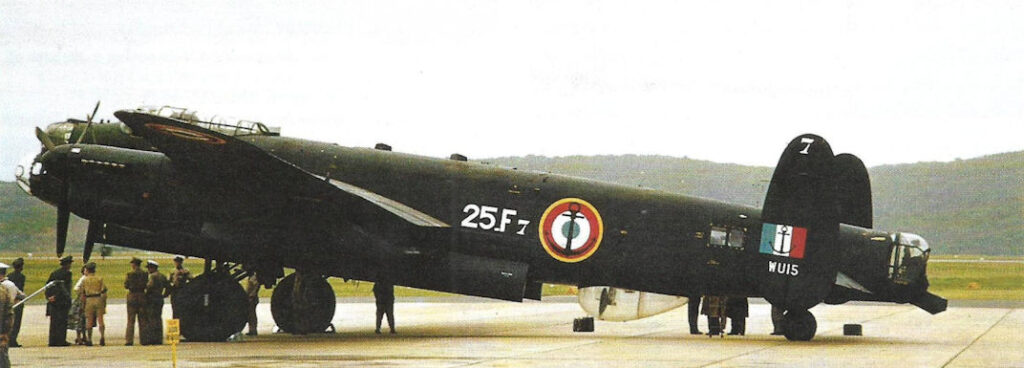
In 1962, WU15 swapped her European theatre of operations for the Far East and was repainted in white tropical colours by UTA at Le Bourget (6). Originally, three Lancasters had been assigned to Escadrille de Servitude 9S in Noumea, New Caledonia, and these were supplemented in late 1962 with WU15, WU13 (ex-NX665) and WU21 (ex-NX664). The 60-hour ferry flight commenced in November 1962 and took a leisurely 23 days with transit stops in Malta, Istanbul, Tehran, India and Phnom Penh, Cambodia. A 50-hour inspection was carried-out while the Lancaster was in Indo China and, upon completion, WU15 was ‘borrowed’ for a cargo run to Seno (Xeno), Laos, to collect 10,000 rounds of ammunition (7). Take-off from the 1500m gravel strip in Laos was reported to be challenging. This was probably WU15’s only contribution to any military operations in Indo China before she continued her journey via Singapore, Djakarta, Bali, Darwin and Townsville.
(6) UTA maintained the Aeronavale Lancasters and held a stock of stripped-out Lancasters as a source of spares.
(7) The ammunition run was presumably on behalf of the French or Cambodian authorities although most French military activity had finished in the mid-fifties.
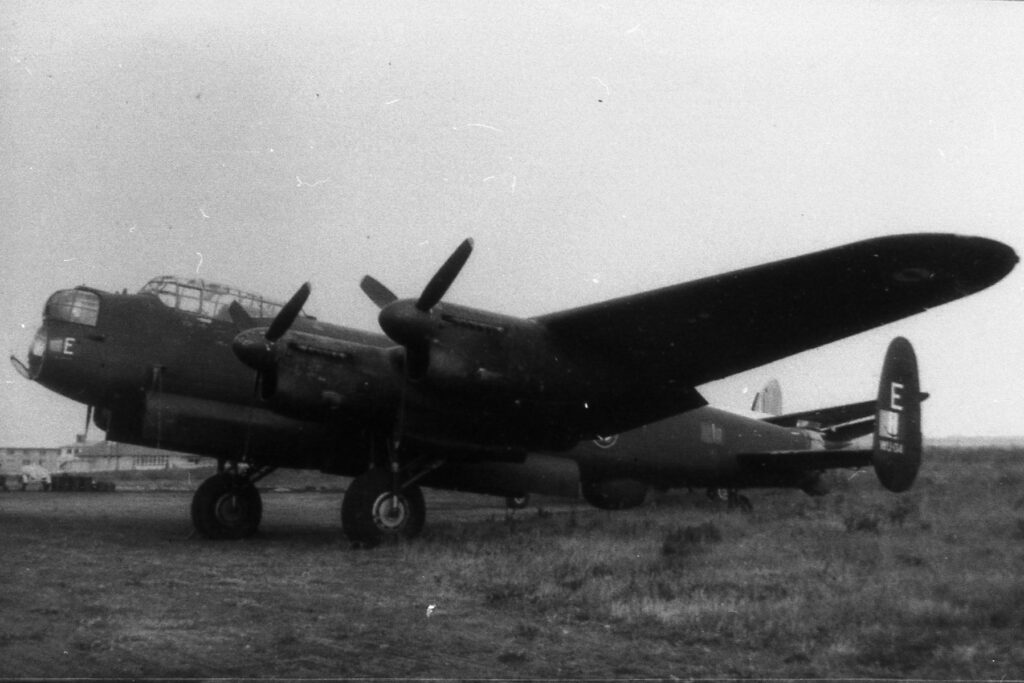
The Lancasters were assigned to reconnaissance, Air Sea Rescue and liason duties in Noumea but their mission was to be of limited duration owing to their scheduled replacement by Lockheed Neptunes – indeed, in November 1962 negotiations had already been concluded to deliver one of the Noumea Lancasters, WU 16, ex NX622, to the Royal Australian Air Force Association in Perth. As rumours circulated regarding the imminent retirement of the remaining Lancasters, the young co-founder of Britain’s Historic Aircraft Preservation Society, Malcolm (Bill) Fisher enquired whether the Aeronavale would be interested in parting with one. It turned out that they would be ! (8). Indeed, not only were they prepared to donate an aircraft, they were prepared to deliver it as far as New Zealand or Australia. In April 1964, the Aeronavale continued with their Lancaster donation programme – NX665, WU13, was gifted to the Royal New Zealand Air Force and was flown to Whenuapai on April 15th. WU15/ NX611 flew to New Zealand along with WU13 in order to return the French crew to Noumea. Departing Whenuapai on 16th April, WU15 cruised along the coast of the North Island before heading back to New Caledonia.
Meanwhile, HAPS’ Bill Fisher, at the time working as a clerk with a Lloyds insurance broker, was building an influential group of contacts to help with his own bid to own a French Lancaster. He called Sir Roy Dobson, a key figure in Avro’s wartime aircraft production (9) who was now part of the Hawker Siddeley management. He agreed to receive the Lancaster at Hawker de Havilland’s Bankstown airfield in Australia and also to donate ten thousand pounds for the cost of the flight back to the UK. A French crew, led by Lt Boulier, delivered WU 15 to Bankstown on August 13th 1964 and work commenced to prepare her for the long flight back to Britain.
(8) In addition to WU 15, NX611, three other Noumea Lancasters have eventually been preserved. For further details of WU 16’s donation to the RAAFA in Perth see ww2talk.com/index.php?threads/lancaster-crews.8774/ . WU 13 traveled to New Zealand and WU 21 (ex-NX664) has eventually made it to Paris with Les Ails Anciens. The Perth-bound Lancaster arrived in Perth during December 1962, well before WU 15 was donated to HAPS.
(9) Sir Roy Dobson had joined A.V.Roe in his early twenties as an apprentice tool fitter and had risen to the point where he commissioned the A.V.Roe factory in Manchester where Lancasters and Ansons were built.
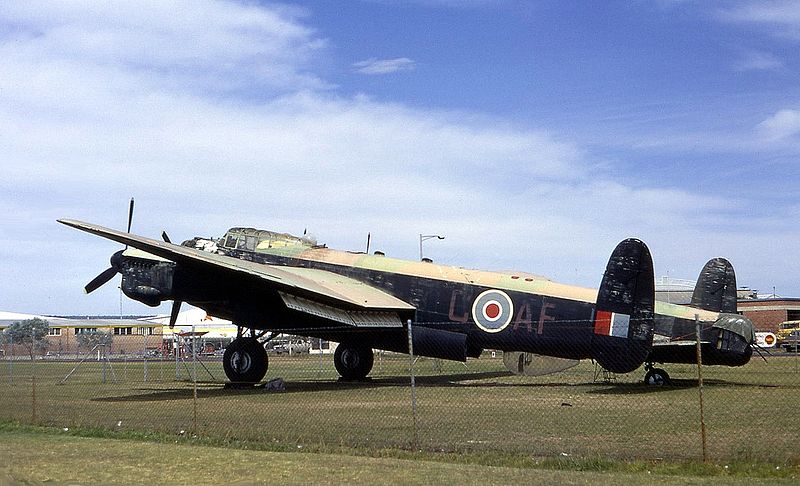
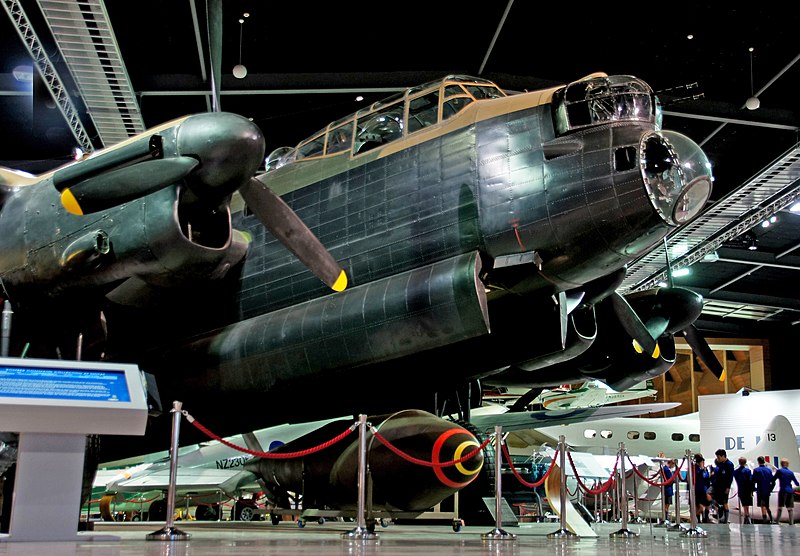
The project to return NX611 to the UK benefited from some generous donors in addition to Hawker Siddeley. Qantas supplied up-rated radio equipment, Shell Aviation arranged the fuel and an ambitious Gold Coast suburb, Surfers Paradise, chipped-in too. A 400 gallon tank was installed in the bomb bay to boost the 2154 gallon wing capacity and a crew of serving and retired RAAF airmen recruited. There was some doubt as to whether the crew documentation conformed 100% with CAA type-certification but, after a thorough overhaul, the Lancaster positioned to Mascott Airport, Sydney. When she departed for Biggin Hill on 25th April 1965, she carried a full complement of crew, passengers and sponsors. At the time of departure, the Lancaster had logged a total time of 2411 hours.
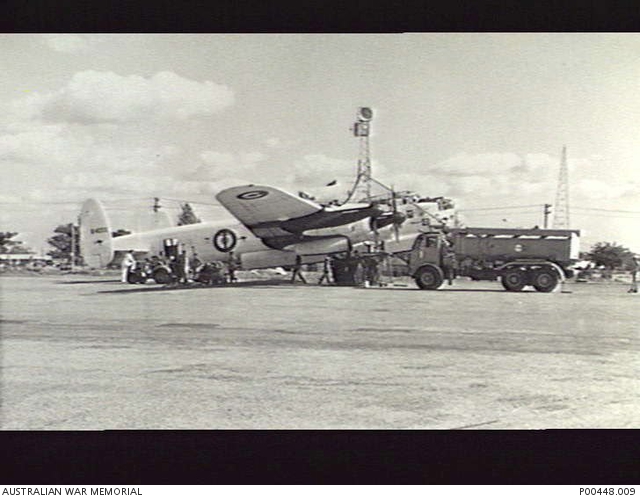
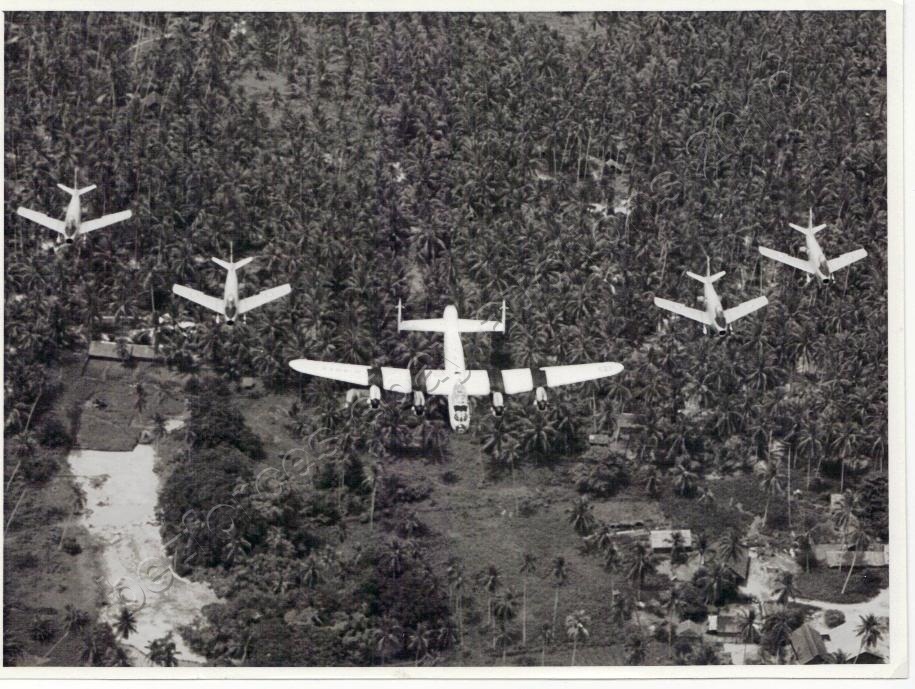
In Australia, planning for the ferry flight was handled by Bruce Miles, a renowned defence lawyer and an ex-RAAF veteran who had been wounded flying Lockheed Venturas over Europe in 1943. He recruited Qantas captain Wing Commander John Hampshire, an ex-Liberator pilot, as the ferry captain. Doug Smedley, an ex-Lancaster pilot and Airlines of NSW captain, would be First Officer. Wing Commander John Nicholls, an ex-Lancaster pilot, was signed-on as the reserve pilot, J.Keith McCarthy as the navigator and Arthur Johnson was given the task of operating the 12-channel VHF radio. The vital job of Flight Engineer was given to Don Delaney and the Lancaster was also due to carry five passengers as photographers and reporters (10).
The 12,000+ mile flight from Mascott to Biggin Hill routed via Coolangatta (Surfers Paradise), Amberley, Darwin, Changi (Singapore) and Butterworth (Malaysia). The departure from Darwin saw two RAAF Sabres escorting the old bomber and four further Sabres greeted her upon arrival at Butterworth. On the ground, NX611 was parked between and Avro Vulcan and a Victor and, upon departure, she was accompanied by an escort of an RAF Victor and Canberra and RAAF Sabres for the first part of the flight to Calcutta. This sector generated some excitement when the Lancaster became lost in a dust storm over India with only 40 minutes of fuel remaining to reach Calcutta/ Barrackpur. Fortunately, a BOAC 707 picked-up their Mayday signal and was able to direct them to a safe landing at their destination….with at least 5 minutes worth of fuel still remaining! Flying onwards to Karachi and Bahrein, challenges other than meteorology cropped up on the sector to Akrotiri in Cyprus. The crew hadn’t received permission to overfly Syrian air space but, in true pioneering style, decided to give it a go anyway. Despite the imminent scramble of Syrian MIG fighters, the crew bluffed their way past Damascus, transited through Akrotiri and, on May 12th, landed in mainland Europe at Marseille/ Istres. The following day, May 13th, was the date scheduled for the Lancaster’s arrival with a 15:30 touchdown time-tabled as part of Biggin Hill’s 1965 Air Fair. Flying north across France, NX611 was escorted across the Channel by RAF Shackleton MR3 XF730 and touched-down 3 minutes late at the end of a 69 hour/ 19 day flight.
The Biggin Hill Air Fair was organised by Jock Maitland, an ex-RAF pilot who had flown F-86s on secondment to the USAF and had, subsequently, operated Vikings and Viscounts under the Maitland Drewery banner. This passenger airline operation was wound-up in 1961 in favour of providing light aircraft services from Biggin Hill. The Maitland Drewery organisation was due to oversee many of the technical aspects of the preservation of Lancaster NX611 and their eventual hope was to display it as part of an air museum at Biggin Hill. HAPS themselves consisted of twenty or so committed enthusiasts with Bill Fisher and Russ Snadden as the driving force. They had assembled a motley collection of interesting , largely redundant aircraft : an ex-Irish Air Corps Walrus amphibian, an Italian Air Force Sabre and a Seafire which had been loaned-out to the RNAS station at Culdrose. However, the Lancaster was a star of a different magnitude and the ability to house it at, and potentially operate it from, Biggin Hill was a key issue for such a large aircraft. The Lancaster had been registered to Fisher and Snadden and allocated the registration G-ASXX but the Air Registration Board had only issued a C of A for the ferry flight. Indeed, the ARB’s man, Paul Whitcher, had made Bill Fisher agree that G-ASXX would not fly again once it had arrived in Britain. HAPS clearly needed additional specialised technical, public relations and administrative inputs and, following G-ASXX’s arrival, their expertise was bolstered by the joining of a number of ex-Bomber Command personnel. Also critical was the participation of Field’s Aircraft Services who provided a team from Heathrow led by Arthur Heath, Tony Hearn and John Catchpole. As well as providing maintenance without charge, Field’s also had the credibility to persuade Paul Whitcher at the ARB that the Lancaster could remain airworthy.
(10) The crew list and many of the ferry flight details are from a WikiTree post chronicling the life of Wing Commander John Brook Hampshire DFC RAAF. The family tree data are managed by Geoffrey Raebel.
After the initial euphoria surrounding the Lancaster’s arrival, HAPS needed to generate income and maintain interest in the project even if it wasn’t likely to be flying anywhere in the short term. The bomber was parked on the grass outside the Surrey and Kent Flying Club cafe before being moved to the Biggin Hill General Aviation area. Maitland and HAPS arranged for visitor access and punters were charged 2/ 6d to walk through the Lancaster from the aft entrance door to the forward escape hatch (11). The Field’s team agreed to paint the bomber and suitable paint was sourced from RAF Scampton – the source didn’t prevent a debate regarding the authenticity of the camouflage applied! Her original RAF serial of NX611 was applied along with code letters HA-P which, coincidentally, represented both the Historic Aircraft Preservation Society and 218 Squadron RAF. It was not until 1967 that the Lancaster was ready to take to the air again. One of HAPS problems was recruiting aircrew with experience of flying a large 4-engine bomber with a tailwheel undercarriage configuration. Fortunately, Bill Fisher knew RAE test pilot Neil Williams via their membership of the Tiger Club (12). Neil had flown various 4-engine ‘tail draggers’ including the Lancaster’s close relations, the Avro Lincoln and Shackleton MR2. The HAPS management team had been joined by John Roast, who worked in the shipping industry, and he was very keen to maximise the publicity potential of G-ASXX by getting her airborne in time for a Dambusters reunion at Scampton in May 1967. Neil Williams and three suitably-qualified flight engineers visited Biggin Hill in the spring of 1967 to run a critical eye over the ex-bomber. The ground assessment was positive and the next stage was a test flight. This was what the ARB’s Paul Whitcher had not wanted to happen and it can be imagined that much technical persuasion must have been input by the Field Aircraft Services team. He need not have worried about that first, May 6th, flight by Neil Williams: the Aeronavale New Caledonia configuration included extra tropical radiators and this meant that the engines ran at too low a temperature, other than that ‘Just Jane’ behaved. No, it was the second flight which would have set the ARB’s blood pressure soaring. Although only of 43 minutes duration, it undoubtedly seemed longer to the flight crew. Just after take-off, the port inner engine suffered a propeller run-away and, failing to feather, this led to the aircraft beginning to climb alarmingly. Displaying the quick-thinking under pressure for which he was famous, Williams applied maximum flap and lowered the undercarriage to slow the ascent. In the interim, the flight engineers found that #3 generator, the fire-extinguisher system, radios and intercom circuits all had issues. Nonetheless, a safe 3-engine touch down was made at Biggin Hill and the crew retained the confidence to make a third flight. This didn’t go smoothly either. Once the undercarriage had been retracted, a blown hydraulic pipe required the emergency in-flight replenishment of the hydraulic reservoir. The port undercarriage remained stubbornly in the nacelle and the engineers had to use the emergency compressed air system. No doubt they were more than a little nervous as to whether this would operate after so many months inaction. Fortunately, it did, a successful landing was made and the Lancaster handed to Field’s for remedial hydraulic maintenance. A proving flight was made on May 17th and the Lancaster appeared at the Scampton reunion event on May 19th/ 20th. The flight from Biggin to Scampton was scheduled to involve an escort of two Spitfires from the RAF’s Historic Flight at Coltishall. However, Spitfire AB910 was diagnosed with engine problems and the HAPS Lancaster departed on its own with the two fighters due to join later. Barnes Wallis was the guest of honour at Scampton and Neil Williams treated the Dambusters veterans to a thorough demonstration of the Lancaster’s abilities on both days before flying back to Biggin Hill.
(11) detail from Bill Fisher’s account of the Lancaster’s HAPS days in ‘Vintage & Classic’ magazine, Issue 47, Autumn 2014.
(12) Neil Williams, a true aviation legend, gained a PPL at 17 and joined the RAF in 1955.He flew Canberras on photo reconnaissance missions before moving to the RAE at Farnborough after further training at the Empire Test Pilots School. His aerobatic talents gained him a place in the British Aerobatic team which he captained from 1967. I was fortunate enough to meet him when he and James Black were practicing aerobatics from the (then) abandoned ex-USAAF airfield at Earls Colne, Essex. He was piloting Zlin G-AWPG, a type of aircraft which he became exceptionally proficient at flying. It was while at Farnborough that he gained experience flying Shackleton MR2s and HP Hastings transports, the kind of 4-engined tail-draggers which suited him to fly Lancaster G-ASXX. His civilian career commenced with the test programme of the Jetstream with Handley Page and, following the demise of HP, Neil made the very natural move to fly Stampes with the Rothman’s Aerobatic Team. In parallel to this, Neil flew many veteran and vintage aircraft and this included every flight of NX611 following her arrival in the UK. During his career, he piloted in excess of 150 different types of aircraft. Tragically, Neil and his wife Lynn were killed in a flying accident on 11th December 1977 when the ex-Spanish Air Force CASA 2.111 (license-built Heinkel HE-111) he was ferrying to Blackbushe in the UK crashed in the Sierra de Guadarrama to the north of Madrid. Neil Williams: a natural pilot, July 10 1934 – December 11 1977.
NX611 was flown again by Neil Williams during the September 1967 St.John’s Ambulance display at Blackbushe. The autumn weather was gusty but the Lancaster maintained impressive flying displays on 2nd and 3rd September with Neil Williams reportedly pulling so much gravity that 22lbs of pop rivets had to be replaced on the upper wing upon its return to Biggin Hill. The same team took the Lancaster to Filton for an air display in June 1968 but the costs of flying the big bomber were becoming prohibitive and every flight involved ‘an arm wrestling contest with the ARB’ (11). Frequently, Field’s technical submissions to the licensing authority had to be supplemented by thinly veiled threats by freelance aviation journalists to expose the ARB’s timidity. Additionally, the RAF’s own Lancaster, PA474, had returned to the air, removing NX611’s unique status and costs effectively grounded G-ASXX at Biggin. By October 1968, John Roast had proposed that HAPS should pursue a more commercial strategy with the ownership of their aircraft passing to a limited company. This would also provide a safeguard against insurance claims being made on the private individuals comprising HAPS. Roast, however, had already created some dissent by trying to negotiate the rental of the Lancasters propellers to the production company filming ‘The Battle of Britain’ at Duxford. The prop lease didn’t go ahead but the new direction for HAPS led to the departure of Bill Fisher and the adoption of John Roast and his wife as directors of a new company. Reflectaire Ltd. The end of the organisation’s charitable status also led to the loss of the free support provided by Jock Maitland and Field’s Aircraft Services. While initially remaining at Biggin Hill, NX611 had now begun to accumulate parking charges and it became apparent that a new home was required. The owners of Thruxton, Fairoaks and Blackbushe were canvassed but none seemed particularly keen and more obscure locations were checked-out.
Lincolnshire and East Anglia had been the WW2 homes of the RAF and USAAF bomber squadrons and, during the late sixties, there was still a scattering of redundant airfields with the vestiges of runways, taxiways and hangars remaining. Lavenham in Suffolk had been the home of USAAF’s 487th Bomb Group commanded by Lt.Col.Beirne Lay Jr and equipped, firstly, with B-24Hs and, subsequently, B-17Gs. The USAAF moved-on by August 1945, the RAF Transport Command had taken over and, by 1948, the airfield was moribund. It was used briefly by 20th Century Fox to make the Darryl F. Zanuck classic ‘Twelve O’Clock High’ starring Gregory Peck (13). In 1968, many of the airfield buildings remained, the main runway was fairly intact and taxiways still existed. Reflectaire started negotiations with David Alston whose family had owned Lodge Farm since 1900 and had allowed the War Office to construct Lavenham airfield while retaining ownership of the land. David and Beth Alston were keen to maintain a historical site at Lavenham and an agreement was made to house the Reflectaire collection at this rather remote and insecure location. The Lancaster was due to fly to Lavenham but needed further engine work plus some aileron reconstruction by Hawker Siddeley at Woodford. The first ex-HAPS aircraft to arrive was therefore the ex-Italian Air Force Sabre G-ATBF which was trucked-in during February 1969. By late March the Lancaster was ready to follow and, on 30th, she departed Biggin Hill heading for Suffolk on a Permit-to-fly piloted by Neil Williams. The BBC filmed the operation and, upon arrival, the crew performed a brief display and a runway ‘beat-up’. In fact, the main runway was already fairly beat-up and starting to crumble away (14). The first two aircraft were later joined by the Reflectaire Seafire VP441 from Culdrose in July 1969 and a variety of ex-military vehicles gathered around the three exhibits.
(13) 487th Bomb Group’s CO Lt.Col Beirne Lay had co-written the novel ‘Twelve O’Clock High’ and it incorporated many memories of both the airfield and the picturesque local town of Lavenham.
(14) The runways had survived the motorway boom which gobbled-up hard core from WW2 East Anglian airfields during the 1960s. They eventually crumbled-away and were dug-up in 1990. Visiting veterans of 487th BG have frequently been offered chunks of the runways as souvenirs when they visit the airfield.

Lavenham was not ideally suited as a museum site; it was a remote, windswept location with poor access to transport. One very welcome guest during Reflectaire’s tenure at Lavenham was Group Captain Leonard Cheshire and his wife, Sue Ryder, who lived locally at Cavendish. Always keen for publicity, John Roast changed the Lancaster’s code letters to GL-C (representing Geoffrey Leonard Cheshire) and invited the Group Captain to taxi NX611. Familiar with Lancasters from his days as CO of 617 Squadron, Cheshire was keen to revisit his aviation skills. Unfortunately, the outing didn’t go to plan: one of the wheel chocks had been left in place and the heavy bomber juddered forwards, crushing the chock. Subsequently, the bomber wandered onto the soft margin of the taxiway and ended-up with one wheel bogged-down on a ploughed area.
One fanciful idea to promote the Lancaster was the suggestion that she should repeat her Sydney to London epic journey but in the opposite direction as part of the forthcoming London to Sydney Air Race. Esso Oil were considering sponsorship and hired Don Delaney, flight engineer on the original ferry flight, to assess the potential of the Lancaster. He traveled to the UK and visited the Lancaster at Lavenham for a couple of days of checks and engine run-ups. Delaney considered that the bomber was scarcely airworthy for short flights within the UK let alone a trans-continental epic and Esso withdrew their backing.
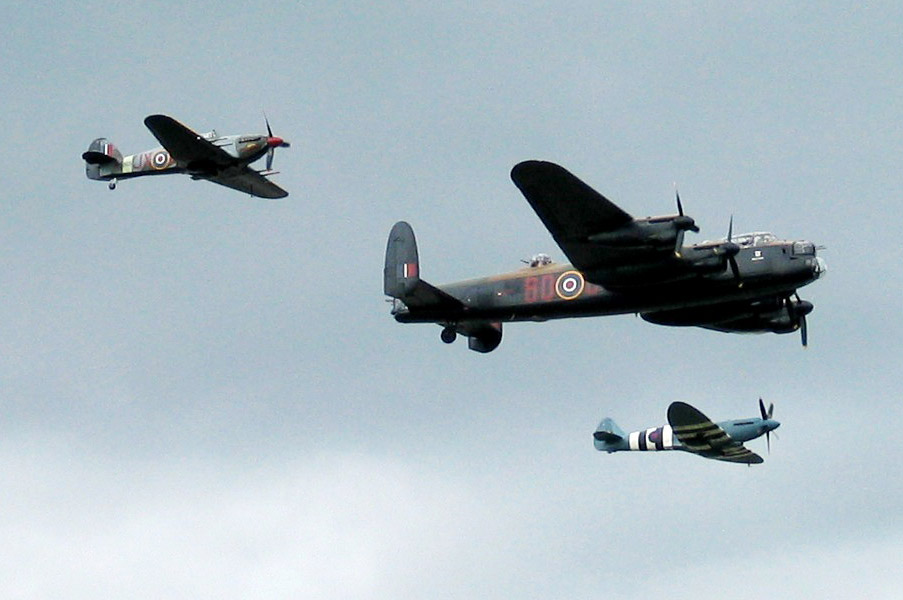
Lavenham’s main attraction had been its availability at a cheap price but, after a few short months, the farmer wanted to charge ground rent, in part to recompense for the stream of visitors crossing his land to access the bomber. Rent was not forthcoming and a deadline was issued for the removal of the Lancaster: December 31st 1969. The hunt for a new home for NX611 began again and, for a while, the ex-airfield, now motor racing circuit of Silverstone looked possible. The Ministry of Defence had also put-out an ‘all airfields’ request on behalf of Reflectaire and the ex-Lancaster base of Hemswell seemed to offer an excellent home. Hemswell had been used for much of the filming of the Dambusters and represented the long history of Lincolnshire Bomber Command airfields. At the time, the airfield was used for gliding and summer camps by the Air Training Corps but was, otherwise, very quiet. This actually proved to be an impediment as the government had decided to offer the airfield for sale and considered the presence of the Reflectaire collection to be an unnecessary complication. In practice, Hemswell was not sold-off immediately as it was used to house displaced East African Asians during 1972.
Eventually, a hangar was found at RAF Hullavington, an airfield already known to Neil Williams who practiced aerobatics there. NX611 was inspected by Hawker Siddeley engineers, a new set of spark plugs was supplied by Smiths Industries, Castrol donated 96 gallons of oil and RAF Wattisham provided the necessary fuel. BBC’s Nationwide programme decided to film the flight and two ex-617 Squadron gunners boarded the Lancaster on 7th February 1970 for the flight to Hullavington. Film star Richard Todd, who had starred in the Dambusters movie (but had, in fact, served with distinction in the Parachute Regiment during WW2), also joined the team on board NX611. With Neil Williams again at the controls and Flight Lt. Eric Hughes navigating the bomber west to Wiltshire, the Lancaster took to the air and made the obligatory low-level pass over Lavenham before heading to her new home. Various small components were reportedly shed along the route but NX611 arrived safely at Hullavington where Guy Gibson’s widow, Eve, and ex-617 Dams veteran Douglas Webb were on hand to welcome the old bomber. While Hullavington offered the luxury of indoor storage in Hangar 85, there was a downside – the station Commanding Officer was unwilling to allow any public access and this cut-off Reflectaire’s potential income stream. Realising that the bomber’s stay at Hullavington was unlikely to be long-term, the owners wisely maximised the benefits of the hangarage to carry-out fairly extensive maintenance. A team of eight Hawker Siddeley engineers worked on the airframe and Rolls Royce checked-out the four Merlins. The cylinder head from #3 engine had to rebuilt by specialist engineers and, by early summer 1970, NX611 was ready to fly again.
This was to be her last flight in the 20th century and was, once again, to be in the capable hands of Neil Williams. However, the aerobatic champion’s availability was nearly cancelled on June 3rd when the Zlin 526 he was flying at Hullavington suffered a near-disasterous structural collapse in flight. The wing spar root cracked during aerobatics and the port wing began to fold. Williams was not using a parachute, so his only option was to land the Czech trainer. He rolled the Zlin to port to snap the wing back into place and then flew an inverted circuit until back over the airfield. Rolling back to starboard at exceptionally low level, the wing tip scythed through vegetation as the aircraft regained upright attitude and set-down messily but without serious injury to Williams. By comparison, his last flight in the Lancaster must have seemed relaxing! On June 26th, NX611 departed Hullavington en route to Blackpool Squires Gate airfield. The Council at the northern town were keen to establish an air museum and housing Reflectaire’s peripatetic collection seemed to be a good start. Ex-617 Squadron bomb aimer Ron Valentine was on board for a 75 minute flight to Blackpool which included a brief excursion for a low-level pass over Lake Bala in Gwynedd, training site for the Dambusters. At Blackpool, the Lancaster proved photogenic as she approached the airport along the sea front with Blackpool Tower prominent in the background.
Neil Williams had flown the Lancaster on all fourteen flights made by the Lancaster since arriving in Britain and Flt.Lt.Eric Hughes had accompanied him as navigator. When she landed at Blackpool, NX611 had been back in England for only five years and was only 25 years old – quite a junior compared to the C-47 Dakotas still earning a living in Florida in 2023! The trip to Blackpool was, to date, NX611’s final flight – if she flies again from her current home of East Kirkby, it will be after a break of over fifty years.
See also : ‘The last Lanc’ by Patrick Kilvington
Key Aero’s: The Amazing Story of Lancaster Just Jane’s flight from Australia by Ben Dunnell.
https://www.key.aero/article/amazing-story-lancaster-just-janes-flight-australia-uk
Initially, Blackpool looked as if it would be a good home for the Lancaster with plenty of potential visitors for an air museum. However, NX611 had only flown on Permits-to-fly and was not fully airworthy. During February of 1971, the ITV epic series ‘Family at War’ featured the Lancaster in a starring role with action shots showing the bomber trundling around Squires Gate and also performing a couple of fast taxis down the main runway. The pilot in charge for the day was Mark Flatman DFC, an ex-member of 617 Squadron who had taken part in the raid on ‘Tirpitz’. The 1971 summer season brought a good bunch of visitors to see the Reflectaire aircraft but, overall, the numbers weren’t stacking-up and the company wasn’t paying rent to Blackpool City Council. Perhaps symbolically, the bomber’s guns were removed in October 1971 (15) and, on November 5th, Reflectaire were served with notice to quit the airport. The company had reached the end of the road and went into administration, the liquidator opting to auction-off the collection of aircraft and vehicles on 29th April 1972. There was some optimism ahead of the sale and, with the Lancaster the star lot (#63), the engines were run-up and a reserve price of twenty-thousand pounds set. Bidding was generally very poor and NX611 was withdrawn when bidding failed to get above 9,500 pounds. Two days later, the bomber was purchased for 12,500 (16) by Lord Lilford of Nateby who had aspirations to return the Lancaster to the skies. He had undoubtedly been fed some very optimistic assessments of the Avro’s serviceability; despite the good work done at Hullavington, NX611 had suffered during close to three years of outside storage in the salty sea air of Lancashire. In particular, the propellers and engines were considered to be in poor condition and Lord Lilford decided to put the aircraft back up for sale to recover his initial outlay plus the airport parking charges. There were no immediate takers and, eventually, a deal was struck with RAF Scampton to dismantle the bomber, transport her to the Lincolnshire airfield and display her as the gate guardian for a period of ten years. The official handover took place at Squires Gate on August 2nd with Lord Lilford ‘handing the keys’ to Group Captain Richard Lockyer, Officer Commanding RAF Scampton. The RAF officer had arrived in Blackpool on board a fellow 4-engined British aircraft, Handley Page Hastings TG568. The Hastings also carried Warrant Officer P.Higgins MBE and his 10-strong team who had dedicated part of their leave to dismantling the Lancaster. An RAF truck towing a ‘Queen Mary’ trailer arrived on August 3rd with the necessary tools and hardware for the project. Despite it being nominally summer, the weather was horrible as the RAF crew commenced work on NX611 during 4th August. However, progress was good and all engines, control surfaces, fins, wheels, bomb doors, tailplanes and propellers had been removed within three days (17).
The Lancaster wasn’t displayed until Spring 1974, but the hard work of the RAF engineers had ensured that it was a success. The Lancaster was installed at the airfield’s entrance along with other aspects of 617 Squadron operations such as Tallboy and Grand Slam bombs and an Upkeep bouncing bomb.
(15) The Daily Express revisited the issue of the bomber’s armaments on 18th December 1972, reporting that RAF armourers had stripped-out a ‘formiddable array of weapons’ in order to ‘prevent the IRA from acquiring its first airplane’. Rather a fanciful theory, even for the Express.
(16) At the time, Control Column magazine reported that the sale price was 10,500.
(17) details from Brian Goulding’s article “Lancasters Last Sortie?’ in Control Column magazine,Vol 7, #9.
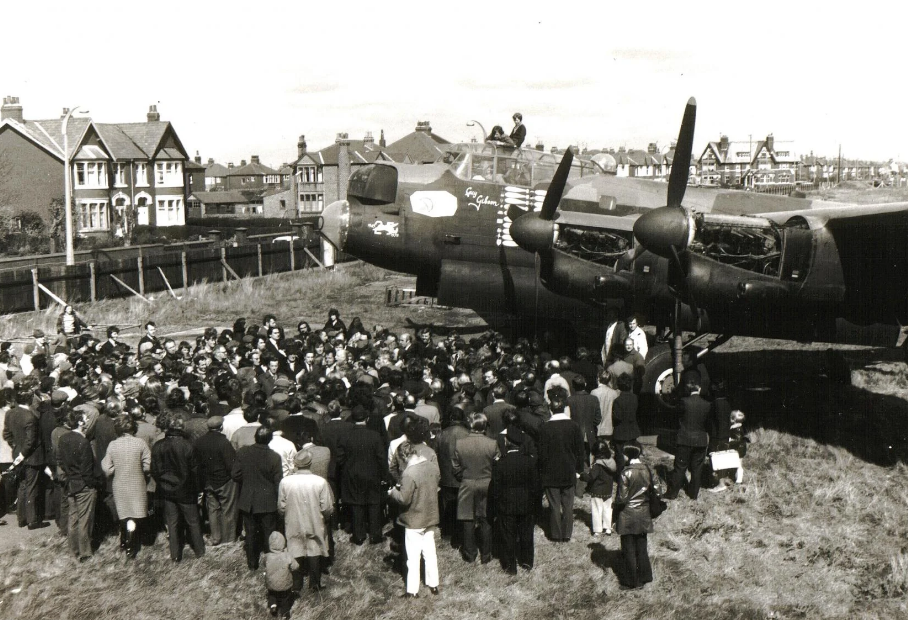
When Scampton’s ten year tenure was drawing to a close purchase negotiations began with various interested parties including potential buyers in the USA. Perhaps surprisingly, the preferred purchasers were two Lincolnshire farmers who planned to make the Lancaster the centre piece of a memorial to the RAF crews which had flown from ‘Bomber County’. Fred and Harold Panton were motivated to create the memorial by the death of their 19-year old elder brother Christopher who had died at the end of March 1944 when flying as Flight Engineer in Halifax HX272, ‘Nielsen’s Nuthouse’ on a raid on Nuremburg with RCAF 433 Porcupine Squadron.
The Panton’s maintained good relations with RAF Scampton having brokered a version of the gate guardian deal back in 1973. Through contacts in the Air Cadets, Squadron Leader Willis at Scampton had agreed to dismantle the Lancaster, transport it to the RAF station, maintain it as a gate guardian and, after five years, deliver it to the Pantons. When Lord Lilford’s team discovered this, they suggested that Scampton should do the same for them but with a ten-year gate guardianship. The RAF agreed to this, with the proviso that the Pantons should have first refusal should NX611 be sold at the end of their tenure. This deal was adhered to although, by September 1983, the market value of the Lancaster had risen considerably. The two farmers had, in the interim, located a suitable home for the bomber at the old Lancaster base of East Kirkby in the south of the county. Government ownership of the airfield had only been relinquished in 1970 and some of the original WW2 buildings remained intact. The Panton brothers bought part of the site in 1981 in preparation for the 1983 purchase of NX611 or the acquisition of an equivalent bomber with RAF service. What they didn’t have, however, was one of the original T2 hangars and, aware of the slow deterioration of the old bomber which had been experienced at Lavenham and Blackpool, it was decided that suitable hangarage would need to be constructed. An increased purchase price was agreed with Lord Lilford and an extended period of residence at Scampton negotiated to permit the construction of a hangar at East Kirkby. In July 1984, an eleven-strong team from RAF Abingdon spent 13 weeks dismantling the bomber and moving it to East Kirkby. They reported that the airframe was in relatively good shape with less corrosion than anticipated. The new home for NX611 developed into the Lincolnshire Aviation Centre, the Lancaster was christened ‘Just Jane’ and, in 1990, an extensive survey of the Lancaster confirmed that her structure and engines were basically sound. Two ex-RAF engineers joined the project and, in January 1994, began to restore engine #3 to working condition. After 728 man hours and a seven thousand pound investment, the team, led by Ian Hickling and Roy Jarmain, managed to successfully run #3 engine followed, a few months later, by Merlin #2. A third engine was then restored and it was decided that the bomber was in a suitable condition to taxi. The first three-engine taxi, over all of ten metres, was achieved on March 24th 1995 and was followed by a public taxiing display on April 22nd. The fourth engine was restored and run-up on July 13th 1995.
A notable event was when the RAF’s Lancaster PA474 overflew East Kirkby to greet its new neighbour. The pilot was Mike Chatterton whose father, John, had been brought-up at East Kirkby and had flown Lancasters on 44 Squadron missions including the ill-fated Nuremburg raid which had taken Christopher Panton’s life. John Chatterton had visited East Kirkby and it was son Mike who was at the controls for the first taxi run at the Lincolnshire Aviation Centre. In September 2014, ‘Just Jane’ was the static part of the ‘Three Lancasters’ airshow at East Kirkby. With all four engines running, she taxiied across the grass as, not one, but two Lancasters flew overhead. The Battle of Britain Memorial Flight Lanc PA474 from Coningsby had been joined by the Canadian Warplane Heritage Museum’s Mark X FM213 for the summer season in Britain. Nick-named ‘Vera’ owing to her ID letters VR A, the Canadian machine had been built in Canada by Victory Aircraft but, otherwise, had a similar history to NX611. Completed in July 1945, she was too late to join in WW2 and, after a period of storage, was diverted to Maritime Reconnaissance and, subsequently, Search & Rescue duties. After a period as a Gate Guardian she was donated to the CWHM at Hamilton International Airport, Mount Hope, Ontario. To see the World’s only two airworthy Lancasters overfly ‘Just Jane’ on the ground was a truly majestic sight and a fitting tribute to the 7377 aircraft built. The three aircraft will continue to commemorate the 55,573 airmen who lost their life flying for Bomber Command during WW2. Given that Bomber Command had 125,000 servicemen, this represented the largest loss of life of any arm of the Commonwealth armed forces and ten per cent of those who lost their life were Canadian. 3500 Lancaster bombers were lost during WW2 while on operations.
NX611 continues to develop with an ambitious programme of restoration involving the exchange of wings and components with the French organisation Les Ailes Anciennes at Le Bourget who are restoring Lancaster NX664, another of the ex-New Caledonia Lancasters. The latter, WU 21 with the Aeronavale, made an emergency landing on January 26th 1963 at Hihifo airstrip in the Wallis Islands and remained on the remote Pacific Island as a hulk until recovered and transported to France in 1984. Another fascinating story…..
Note: much of the above information is from the sites www.on-target-aviation.com and www.silkscreenphotography.co.uk. Details of WU 21 and French maritime Lancasters are partly from Key Aero article ‘Submarine Hunting Lancasters’ by Malcolm V.Lowe, November 2022.
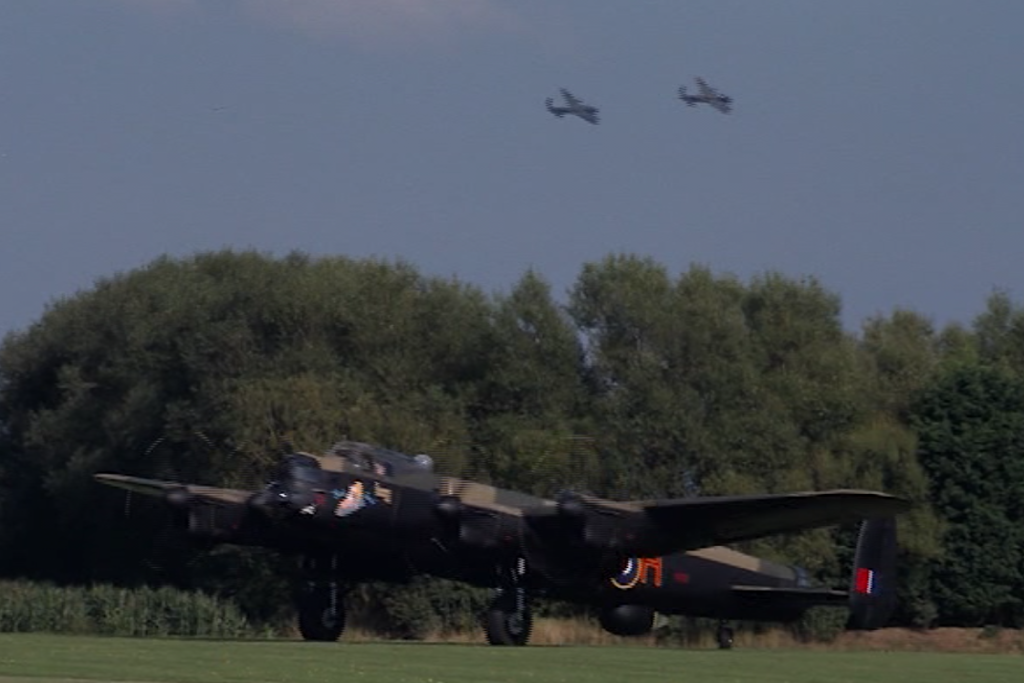
Hits: 193
